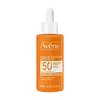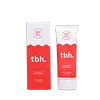What's inside
What's inside
 Key Ingredients
Key Ingredients

 Benefits
Benefits

 Concerns
Concerns

 Ingredients Side-by-side
Ingredients Side-by-side

Bis-Ethylhexyloxyphenol Methoxyphenyl Triazine
Skin ConditioningButyl Methoxydibenzoylmethane
UV AbsorberEthylhexyl Triazone
UV AbsorberHomosalate
Skin ConditioningEthylhexyl Salicylate
UV AbsorberPhenylbenzimidazole Sulfonic Acid
UV AbsorberAminomethyl Propanol
BufferingAcrylates/C10-30 Alkyl Acrylate Crosspolymer
Emulsion StabilisingAloe Barbadensis Leaf Juice
Skin ConditioningBenzyl Alcohol
PerfumingButyloctyl Salicylate
Skin ConditioningTocopheryl Acetate
AntioxidantDibutyl Adipate
EmollientDimethicone
EmollientDisodium EDTA
Ethylhexylglycerin
Skin ConditioningGlycerin
HumectantPhenoxyethanol
PreservativeWater
Skin ConditioningPvp
Emulsion StabilisingSodium Hyaluronate
HumectantBis-Ethylhexyloxyphenol Methoxyphenyl Triazine, Butyl Methoxydibenzoylmethane, Ethylhexyl Triazone, Homosalate, Ethylhexyl Salicylate, Phenylbenzimidazole Sulfonic Acid, Aminomethyl Propanol, Acrylates/C10-30 Alkyl Acrylate Crosspolymer, Aloe Barbadensis Leaf Juice, Benzyl Alcohol, Butyloctyl Salicylate, Tocopheryl Acetate, Dibutyl Adipate, Dimethicone, Disodium EDTA, Ethylhexylglycerin, Glycerin, Phenoxyethanol, Water, Pvp, Sodium Hyaluronate
Water
Skin ConditioningGlycerin
HumectantEDTA
C12-15 Alkyl Benzoate
AntimicrobialOctocrylene
UV AbsorberButyl Methoxydibenzoylmethane
UV AbsorberBenzophenone-3
UV AbsorberPotassium Cetyl Phosphate
EmulsifyingSorbitan Stearate
EmulsifyingCetearyl Alcohol
EmollientGlyceryl Stearate
EmollientTocopherol
AntioxidantAcrylates/C10-30 Alkyl Acrylate Crosspolymer
Emulsion StabilisingSodium Hydroxide
BufferingPhenylbenzimidazole Sulfonic Acid
UV AbsorberPhenoxyethanol
PreservativeIodopropynyl Butylcarbamate
PreservativeEthylhexylglycerin
Skin ConditioningWater, Glycerin, EDTA, C12-15 Alkyl Benzoate, Octocrylene, Butyl Methoxydibenzoylmethane, Benzophenone-3, Potassium Cetyl Phosphate, Sorbitan Stearate, Cetearyl Alcohol, Glyceryl Stearate, Tocopherol, Acrylates/C10-30 Alkyl Acrylate Crosspolymer, Sodium Hydroxide, Phenylbenzimidazole Sulfonic Acid, Phenoxyethanol, Iodopropynyl Butylcarbamate, Ethylhexylglycerin
 Reviews
Reviews

Ingredients Explained
These ingredients are found in both products.
Ingredients higher up in an ingredient list are typically present in a larger amount.
Acrylates/C10-30 Alkyl Acrylate Crosspolymer is a synthetic polymer. It is used to thicken and improve the texture of products. Due to its properties, it can prevent water and oil ingredients from separating.
Also known as Avobenzone, this ingredient is a chemical sunscreen filter that provides protection in the UV-A range.
Avobenzone is globally approved and is the most commonly used UV-A filter in the world.
Studies have found that avobenzone becomes ineffective when exposed to UV light (it is not photostable; meaning that it breaks down in sunlight). Because of this, formulations that include avobenzone will usually contain stabilizers such as octocrylene.
However, some modern formulations (looking at you, EU!) are able to stabilize avobenzone by coating the molecules.
Avobenzone does not protect against the UV-B range, so it's important to check that the sunscreen you're using contains other UV filters that do!
The highest concentration of avobenzone permitted is 3% in the US, and 5% in the EU.
Learn more about Butyl MethoxydibenzoylmethaneEthylhexylglycerin (we can't pronounce this either) is commonly used as a preservative and skin softener. It is derived from glyceryl.
You might see Ethylhexylglycerin often paired with other preservatives such as phenoxyethanol. Ethylhexylglycerin has been found to increase the effectiveness of these other preservatives.
Glycerin is already naturally found in your skin. It helps moisturize and protect your skin.
A study from 2016 found glycerin to be more effective as a humectant than AHAs and hyaluronic acid.
As a humectant, it helps the skin stay hydrated by pulling moisture to your skin. The low molecular weight of glycerin allows it to pull moisture into the deeper layers of your skin.
Hydrated skin improves your skin barrier; Your skin barrier helps protect against irritants and bacteria.
Glycerin has also been found to have antimicrobial and antiviral properties. Due to these properties, glycerin is often used in wound and burn treatments.
In cosmetics, glycerin is usually derived from plants such as soybean or palm. However, it can also be sourced from animals, such as tallow or animal fat.
This ingredient is organic, colorless, odorless, and non-toxic.
Glycerin is the name for this ingredient in American English. British English uses Glycerol/Glycerine.
Learn more about GlycerinPhenoxyethanol is a preservative that has germicide, antimicrobial, and aromatic properties. Studies show that phenoxyethanol can prevent microbial growth. By itself, it has a scent that is similar to that of a rose.
It's often used in formulations along with Caprylyl Glycol to preserve the shelf life of products.
This ingredient is more commonly known as Ensulizole, a chemical sunscreen ingredient.
Ensulizole mainly protects UV-B (290-340 nm) but offers a little UV-A (320-400 nm) protection. It is often paired with less photo-stable sunscreen ingredients due to its photo-stability.
Due to it being water-soluble, Ensulizole helps give sunscreens a light and non-oily texture.
Ensulizole is approved worldwide:
Learn more about Phenylbenzimidazole Sulfonic AcidWater. It's the most common cosmetic ingredient of all. You'll usually see it at the top of ingredient lists, meaning that it makes up the largest part of the product.
So why is it so popular? Water most often acts as a solvent - this means that it helps dissolve other ingredients into the formulation.
You'll also recognize water as that liquid we all need to stay alive. If you see this, drink a glass of water. Stay hydrated!
Learn more about Water